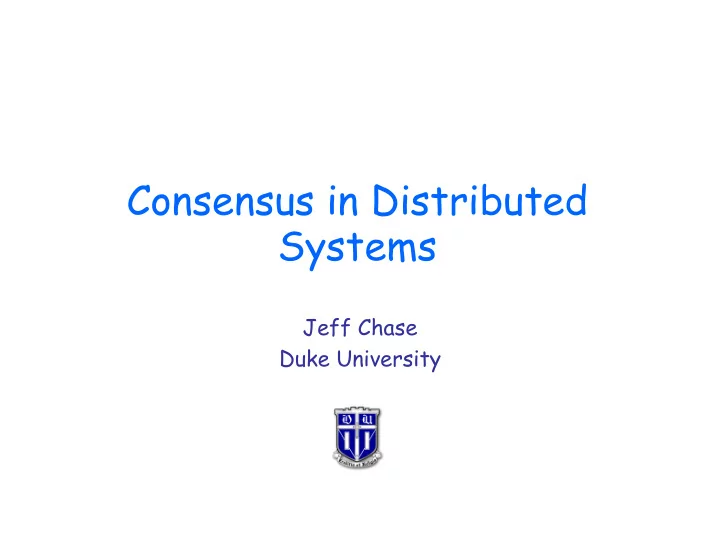

Consensus in Distributed Systems Jeff Chase Duke University
Consensus P 1 P 1 v 1 d 1 Unreliable Consensus multicast algorithm P 2 P 3 P 2 P 3 v 2 d 2 v 3 d 3 Step 1 Step 2 Propose. Decide. Generalizes to N nodes/processes.
Fischer-Lynch-Patterson (1985) • No consensus can be guaranteed in an asynchronous communication system in the presence of any failures. • Intuition: a “failed” process may just be slow, and can rise from the dead at exactly the wrong time. • Consensus may occur recognizably on occasion, or often. • e.g., if no inconveniently delayed messages • FLP implies that no agreement can be guaranteed in an asynchronous system with byzantine failures either.
Consensus in Practice I • What do these results mean in an asynchronous world? – Unfortunately, the Internet is asynchronous, even if we believe that all faults are eventually repaired. – Synchronized clocks and predictable execution times don’t change this essential fact. • Even a single faulty process can prevent consensus. • The FLP impossibility result extends to: – Reliable ordered multicast communication in groups – Transaction commit for coordinated atomic updates – Consistent replication • These are practical necessities, so what are we to do?
Consensus in Practice II • We can use some tricks to apply synchronous algorithms: – Fault masking : assume that failed processes always recover, and define a way to reintegrate them into the group. • If you haven’t heard from a process, just keep waiting… • A round terminates when every expected message is received. – Failure detectors : construct a failure detector that can determine if a process has failed. • A round terminates when every expected message is received, or the failure detector reports that its sender has failed. • But: protocols may block in pathological scenarios, and they may misbehave if a failure detector is wrong.
Consistency Three Properties You Want Pick Two Partition-Resilience Availability [Fox/Brewer]
Committing Distributed Transactions • Transactions may touch data stored at more than one site. – Each site commits (i.e., logs) its updates independently. • Problem : any site may fail while a commit is in progress, but after updates have been logged at another site. – An action could “partly commit”, violating atomicity. – Basic problem: individual sites cannot unilaterally choose to abort without notifying other sites. – “Log locally, commit globally.”
Two-Phase Commit (2PC) • Solution : all participating sites must agree on whether or not each action has committed. – Phase 1 . The sites vote on whether or not to commit. • precommit : Each site prepares to commit by logging its updates before voting “yes” (and enters prepared phase). – Phase 2 . Commit iff all sites voted to commit. • A central transaction coordinator gathers the votes. • If any site votes “no”, the transaction is aborted. • Else, coordinator writes the commit record to its log. • Coordinator notifies participants of the outcome. • Note : one server ==> no 2PC is needed, even with multiple clients.
The 2PC Protocol 1. Tx requests commit, by notifying coordinator ( C ) – C must know the list of participating sites. 2. Coordinator C requests each participant ( P ) to prepare . 3. Participants validate, prepare, and vote. – Each P validates the request, logs validated updates locally, and responds to C with its vote to commit or abort . – If P votes to commit, Tx is said to be “prepared” at P . 4. Coordinator commits. – Iff P votes are unanimous to commit, C writes a commit record to its log, and reports “success” for commit request. Else abort . 5. Coordinator notifies participants. – C asynchronously notifies each P of the outcome for Tx . – Each P logs outcome locally and releases any resources held for Tx .
Handling Failures in 2PC 1. A participant P fails before preparing. – Either P recovers and votes to abort, or C times out and aborts. 2. Each P votes to commit, but C fails before committing. – Participants wait until C recovers and notifies them of the decision to abort. The outcome is uncertain until C recovers. 3. P or C fails during phase 2, after the outcome is determined. – Carry out the decision by reinitiating the protocol on recovery. – Again, if C fails, the outcome is uncertain until C recovers.
Recommend
More recommend